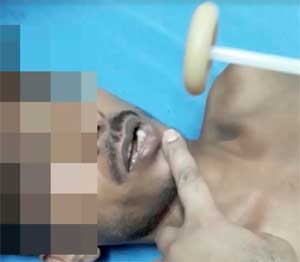- Home
- Editorial
- News
- Practice Guidelines
- Anesthesiology Guidelines
- Cancer Guidelines
- Cardiac Sciences Guidelines
- Critical Care Guidelines
- Dentistry Guidelines
- Dermatology Guidelines
- Diabetes and Endo Guidelines
- Diagnostics Guidelines
- ENT Guidelines
- Featured Practice Guidelines
- Gastroenterology Guidelines
- Geriatrics Guidelines
- Medicine Guidelines
- Nephrology Guidelines
- Neurosciences Guidelines
- Obs and Gynae Guidelines
- Ophthalmology Guidelines
- Orthopaedics Guidelines
- Paediatrics Guidelines
- Psychiatry Guidelines
- Pulmonology Guidelines
- Radiology Guidelines
- Surgery Guidelines
- Urology Guidelines
Safdarjung Hospital doctors report classical case of Jaw clonus and limb fasciculations

Dr Ankur Wadhwa, D.M. at Vardhaman Mahavir Medical College and Safdarjung Hospital, New Delhi, India and colleagues have reported a classical case of Jaw clonus and limb fasciculations. The case has appeared in NEJM.
Fasiculations are a hallmark symptom of diseases that affect the lower motor neurons, like amyotrophic lateral sclerosis, better known as ALS or Lou Gehrig disease. Other lower motor neuron diseases that may cause fasciculations include post-polio syndrome, spinal muscular atrophy, and progressive muscular atrophy.
According to history, a 24-year-old man presented to the neurology clinic with a 1-year history of progressive dysphagia, dysarthria, and weakness in his arms and legs. Three months before the onset of these symptoms, he had received an electric shock while repairing an electric fan; the contact point was the right hand, which had touched an uninsulated wire. The physical examination was notable for clonus of the jaw, brisk deep tendon reflexes in the arms and legs, and fasciculations of the tongue and of the muscles in the arms and legs.
“Clonus of the jaw is a rare but fascinating clinical sign usually seen in patients with severe damage to Corticobulbar tracts especially involving the Supranuclear Trigeminal pathways. Although described way back in 1885-86, it is uncommonly seen and often missed in clinical practice. It has been shown to have a higher frequency when compared to the clonus involving the limbs (ankle& knee) probably due to a shorter reflex arc,” Dr.Ankur Wadhwa, D.M. at Vardhaman Mahavir Medical College and Safdarjung Hospital, New Delhi told Medical Dialogues.
“Our patient was a young adult, who presented with rapidly progressive involvement of both upper and lower motor neurons. He had brisk reflexes with diffuse fasiculations throughout the body and a distinctive jaw clonus. Apart from ALS it has also been described in patients of vascular dementia and multi-infarct states that damage the corticobulbar fibers,” he added.
The sensory examination was normal. Nerve-conduction studies of the median, ulnar, tibial, and common peroneal nerves on both sides of the body showed the diminished amplitude of compound muscle action potentials. Electromyography revealed neurogenic motor unit action potentials, with fasciculation potentials in the tongue and in all limbs. These findings were consistent with chronic motor denervation and reinnervation. Magnetic resonance imaging of the brain and spinal cord revealed no abnormalities.
Given the presence of both upper and lower motor neuron signs with sparing of the sensory pathways, a diagnosis of amyotrophic lateral sclerosis was made. Jaw clonus typically indicates damage to the upper motor neurons in the corticopontine tracts. At follow-up 6 months after the diagnosis was made, the patient had worsening limb and bulbar muscle weakness and atrophy.

Disclaimer: This site is primarily intended for healthcare professionals. Any content/information on this website does not replace the advice of medical and/or health professionals and should not be construed as medical/diagnostic advice/endorsement or prescription. Use of this site is subject to our terms of use, privacy policy, advertisement policy. © 2020 Minerva Medical Treatment Pvt Ltd